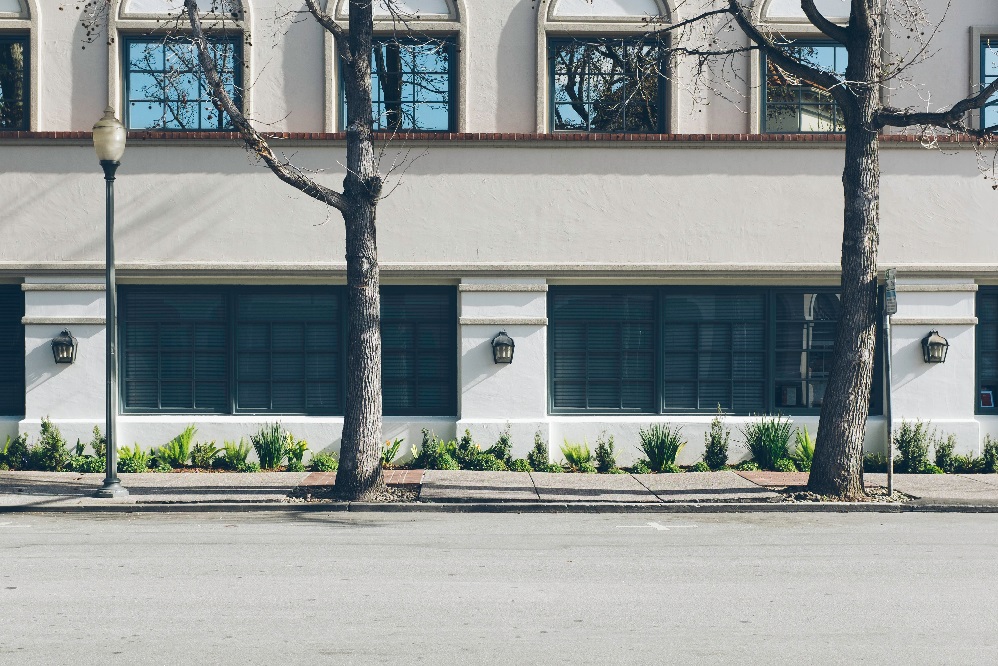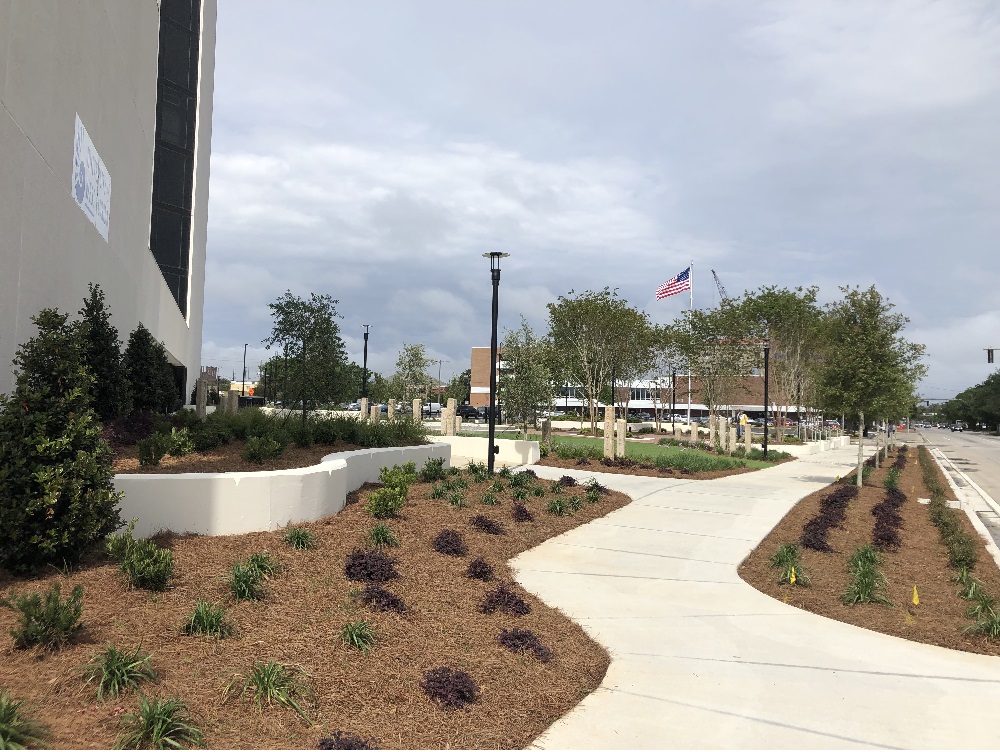
Creating a People-Friendly Streetscape
How do you feel about the streets in your neighborhood?
Do they strike you as being pretty, pedestrian-friendly or safe? Or, are they just a place where people get from A to B, encapsulated in their cars and perhaps driving quickly?
Streetscaping is worth talking about because it’s something that can add value to an area, both in terms of financial value and quality of life. It’s about creating spaces for people, something we are passionate about at Jerry Pate Design.
Get the bonus content: Street Update Checklist
What is streetscaping?
We like this definition, borrowed from a University of Delaware presentation:
“Streetscaping is used to describe the natural and built fabric of the street, and defined as the design quality of the street and its visual effect.”
This definition acknowledges that our streets are public places where people may engage in all sorts of activities. The whole design and experience of the streetscape will influence how the space is used and how people behave in it. Streetscaping “ultimately helps define a community’s aesthetic quality, economic activity, health, and sustainability.”
Considerations for streetscaping
What should a street really be for? Many people think of the street as a thoroughfare for vehicular traffic, but streetscaping is about much more than that. It’s true that at some point over the last few decades, transportation became the dominant feature on our streets, but there are many reasons to consider vehicles as just another part of the whole fabric.
From the University of Delaware presentation: “Transportation systems must consider the context or physical setting and use design approaches and materials that are consistent with local conditions.”
Streets should be for people to use, no matter what mode they are taking. Those who walk or ride a bike should be considered as much as anyone in a car. It’s also important to consider what the main activities are on the street; who lives there or what businesses are set up? Streetscaping can help to improve the aesthetic, value and usability of the street. It can encourage people to go shopping or use amenities. Being sensitive to the local context in terms of the functions of the street is important.
When we talk about “people-friendly” streetscaping, safety is one of the big issues that come to mind. A street where cars are able to zoom by and there is little space for pedestrians is common in many areas, but unsafe.
Streets should be for people to use, no matter which mode they take
As a whole, for the health and wellness of the population, it’s worthwhile to do what we can to encourage different modes of transport. For example, 2017 data showed that while the number of American adults who walk for exercise or to get from place to place has improved, figures were still at just 65% for females and 63% for males.
One article sited the study and its lead author, Emily Ussery: “Communities can help get people walking by making streets safer and promoting walking programs. ‘People need access to convenient and safe places to walk,’ she [Ussery] said.”
So to summarize, here are some key factors you might consider for your streetscape:
- What makes it safe and enjoyable for people?
- How can you make it aesthetically pleasing?
- How can you enhance the current activities in the street?
- How can you encourage new activities that the neighborhood would like?
- How do you do all these things and maintain the functionality of the street?
Streetscaping ideas
Street safety
First up, let’s look at some ideas for making streetscapes safer for pedestrians and others. One thing we have done in streetscaping projects is to assess how the traffic flows through the street and how that impacts safety. Features like straight-through lanes can encourage drivers to speed up – basically you don’t want anything that looks like a race track.
To that end, we like the “road diet” for slowing cars down. This can involve narrowing the travel lanes or inserting side islands that naturally force traffic to slow down. At the same time, we complement this with widened sidewalks for pedestrians. We may even add a strip that acts as a buffer between pedestrians and traffic, such as with a garden or tree plantings. See some pictures below from our Southtowne streetscaping in Pensacola.
[Insert Pictures and explanations in here]
Some other aspects of safety to consider include visibility, both during the day and at night. For example, sometimes the design of the street or the layout of current plantings impairs driver or pedestrian visibility. If you can open up corners or create refuges for pedestrians, you can help with the overall feeling of safety.
Separating pedestrians from traffic at SCI Plaza

Consider street lighting as well. This helps to improve safety and visibility overall, including deterring crime.
Crosswalks can help to improve safety for pedestrians, but they must be designed properly. This includes giving them high visibility with signs and lighting where possible. In areas where crosswalks are installed without signage, you’ll often see cars drive straight through paying no mind to pedestrians.
Another safety aspect could include where you encourage traffic to go. For example, if people were to park their cars to visit shops or amenities, where are you sending them to do that? Removing street parking can eliminate another hazard to people and visibility, but you need to consider whether there is enough alternative parking nearby so that people are still encouraged to use the amenities on the street.
Street aesthetics
Beautifying the street isn’t just a “feel good” activity, it has other, peripheral benefits too. For example, people like being there! This can encourage economic growth as they shop at local businesses or eat at the restaurants. It can help to improve property values in the area.
Landscaping efforts can also help to encourage wildlife, such as by planting things that bees like or attracting birds. This has wider implications for the local ecology. In short, attracting the right wildlife helps things to grow.
Planting may also be strategic in terms of preventing urban “heat islands” and helping to provide some shelter. It can tie in with safety in terms of making planting decisions that maintain visibility.
Your aesthetic appeal might include hardscaping as well as landscaping. There might be practical aspects such as seating. You might also want to consider any elements that lend a “sense of place.” For example, sculptures or other features relevant to the area. See some of our project examples below.
[Space here for photos and explanations of Jerry Pate projects]
Street amenities
This is where you consider the activities the street is used for and who is doing them. For example, you may include bicycle racks, seating or even charging for electric vehicles. If you’re in an area that gets hot and you want to encourage walking, you might think about things like shade and water fountains to keep people cool.
Accessibility is another important factor to consider. It’s not just that there are ADA and local laws you’ll need to follow – there may be aspects outside of what is strictly required that will be great to have. The design of streetscapes is important for people of all abilities – consulting with the local community is a good idea.
Get the bonus content: Street Update Checklist
Final thoughts
People-friendly streetscapes become important community features. Think of streets as not just being about moving vehicles, but connecting people with the activities they want to do in the mode they want to take.
Safety is definitely one of the primary considerations, but aesthetics and the usefulness of the space should also come into the planning phase. Urban streets can be a pleasant part of a prosperous place.